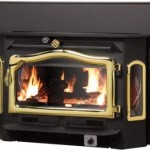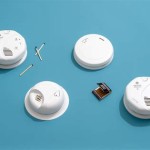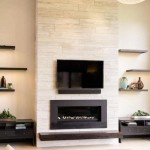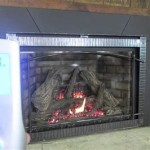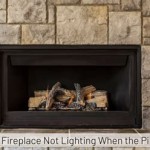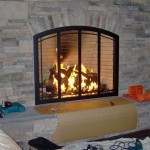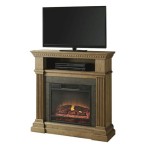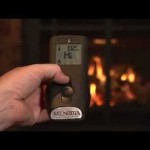Best Gas Fireplace Insert: Direct Vent Options for Efficient Heating
Gas fireplace inserts offer a convenient and efficient method of upgrading an existing fireplace. Direct vent models, in particular, stand out due to their sealed combustion systems, which enhance safety and heating performance. Choosing the "best" gas fireplace insert requires careful consideration of several factors, including heating capacity, efficiency ratings, design aesthetics, and installation requirements. This article will explore key aspects of direct vent gas fireplace inserts, providing information to aid in selecting a suitable unit for individual needs.
Direct vent gas fireplace inserts operate by drawing combustion air from outside the home and expelling exhaust gases directly outdoors through a dedicated venting system. This sealed system prevents indoor air from being used for combustion, eliminating the risk of carbon monoxide entering the living space. The direct vent design also contributes to improved heating efficiency, as the unit is not drawing pre-heated room air for operation. This results in more consistent and comfortable warmth throughout the room, while potentially lowering energy bills.
Key Point 1: Understanding Direct Vent Technology
The core advantage of a direct vent gas fireplace insert lies in its closed combustion system. Unlike traditional fireplaces or vent-free gas logs, direct vent models do not rely on existing chimney structures for ventilation. Instead, they utilize a dual-pipe system, one pipe drawing fresh air from the outside and the other expelling exhaust gases. This system provides a complete separation between the combustion process and the indoor environment. This design considerably reduces the risk of backdrafting, where exhaust gases are drawn back into the home, potentially leading to carbon monoxide poisoning.
The venting system for a direct vent insert typically consists of concentric or coaxial pipes. The inner pipe expels exhaust, while the outer pipe draws in fresh air. This arrangement allows for heat exchange between the exhaust gases and the incoming air, further enhancing the overall efficiency of the unit. The venting can be routed horizontally through an exterior wall or vertically through the roof, offering flexibility in installation options. The specific venting requirements will vary depending on the manufacturer and model, necessitating careful adherence to installation guidelines.
Efficiency is another significant benefit of direct vent technology. Because the system is sealed, it minimizes heat loss up the chimney. The heat generated during combustion is primarily directed into the room, rather than escaping through a poorly insulated flue. This makes direct vent inserts a more effective heating solution compared to open fireplaces, which often lose a significant portion of their heat through the venting system. The increased efficiency translates to lower gas consumption and reduced heating costs over time.
Key Point 2: Factors to Consider When Selecting a Direct Vent Insert
Several crucial factors must be evaluated when selecting a direct vent gas fireplace insert. These include heating capacity measured in British Thermal Units (BTUs), efficiency ratings such as Annual Fuel Utilization Efficiency (AFUE), the size and design of the insert, venting requirements, and overall cost. A careful assessment of these factors will ensure that the chosen insert meets the specific heating needs and aesthetic preferences of the homeowner.
Heating capacity, measured in BTUs, determines the amount of heat the insert can generate. The appropriate BTU output will depend on the size of the room to be heated and the climate in which the home is located. A larger room or colder climate will require a higher BTU rating. Over sizing the insert can lead to uncomfortable overheating, while under sizing may not provide adequate warmth. Consulting with a qualified HVAC professional can help determine the optimal BTU output for the specific heating needs.
Efficiency ratings, particularly AFUE, indicate how efficiently the insert converts fuel into usable heat. A higher AFUE rating signifies greater efficiency, meaning that more of the gas is used to produce heat and less is wasted up the vent. Direct vent gas inserts often boast AFUE ratings of 70% or higher, which is significantly more efficient than traditional open fireplaces. Choosing an insert with a high AFUE rating can result in substantial energy savings over the lifespan of the unit.
The size and design of the insert must also be considered to ensure a proper fit within the existing fireplace opening and to complement the overall décor of the room. Direct vent inserts come in a variety of sizes and styles, ranging from traditional to contemporary. Measuring the fireplace opening accurately is essential to select an insert that will fit properly. The design of the insert should also align with the homeowner's aesthetic preferences, as the fireplace often serves as a focal point in the room.
Venting requirements can impact the installation costs and complexity. Some direct vent inserts require specific venting configurations or have limitations on venting length and direction. It is crucial to review the manufacturer's venting specifications carefully and to ensure that the venting system can be installed safely and effectively in the home. In some cases, modifications to the existing structure may be necessary to accommodate the venting requirements.
The overall cost of a direct vent gas fireplace insert includes the purchase price of the unit, the cost of installation, and ongoing operating expenses. Installation costs can vary depending on the complexity of the venting system and any necessary modifications to the existing fireplace. Operating expenses primarily consist of the cost of gas, which will depend on usage patterns and local gas prices. Evaluating the total cost of ownership over the lifespan of the insert is essential to making an informed purchasing decision.
Key Point 3: Installation and Maintenance of Direct Vent Inserts
Proper installation and regular maintenance are crucial for ensuring the safe and efficient operation of a direct vent gas fireplace insert. Installation should be performed by a qualified professional with experience in gas appliance installation. Regular maintenance, including cleaning and inspection, can help to prevent problems and extend the lifespan of the unit.
Installation typically involves connecting the insert to the gas line, installing the venting system, and ensuring that the unit is properly sealed and secured within the fireplace opening. A qualified installer will verify that all connections are tight and leak-free and that the venting system is installed according to the manufacturer's specifications. Improper installation can lead to gas leaks, carbon monoxide poisoning, and other safety hazards.
Regular maintenance should include cleaning the glass front of the insert, inspecting the burner assembly, and checking the venting system for obstructions or damage. The glass front can be cleaned with a specialized fireplace glass cleaner to remove soot and residue. The burner assembly should be inspected for any signs of corrosion or damage, and any necessary repairs should be performed promptly. The venting system should be checked regularly for bird nests, debris, or other obstructions that could impede airflow. It is advisable to have the insert professionally inspected and serviced annually to ensure optimal performance and safety.
While direct vent gas fireplace inserts generally offer convenient and efficient heating, issues may arise that require troubleshooting. Common problems include pilot light outages, burner malfunctions, and venting obstructions. If a pilot light repeatedly goes out, it may indicate a problem with the gas supply or the thermocouple. Burner malfunctions can result in uneven flames or reduced heat output. Venting obstructions can cause backdrafting and carbon monoxide buildup. Addressing such problems promptly is essential for maintaining the safety and performance of the unit.
Direct vent gas fireplace inserts offer a safe, efficient, and aesthetically pleasing way to improve home heating and ambiance. Understanding direct vent technology, considering key selection factors, and ensuring proper installation and maintenance are all critical to maximizing the benefits of these appliances. Careful planning and research will help homeowners choose the "best" direct vent gas fireplace insert to meet their individual needs and preferences.

Best Gas Fireplace Inserts Fireplaces Direct Learning Center
.aspx?strip=all)
Top 11 Gas Fireplace Insert Trends Of 2024

Best Gas Fireplace Inserts Fireplaces Direct Learning Center

Best Gas Fireplace Inserts Fireplaces Direct Learning Center

Direct Vent Gas Fireplace Insert Mpi27

Rushmore 30 Direct Vent Fireplace Insert Fine S Gas

Gas Fireplace Inserts Pros And Cons Of Ventless Fireplaces

Majestic Ruby 35 Direct Vent Gas Insert Ruby35 North Country Fire

Best Gas Fireplace Inserts Fireplaces Direct Learning Center

Best Gas Fireplace Insert Top 5 For Existing Fireplaces
Related Posts

